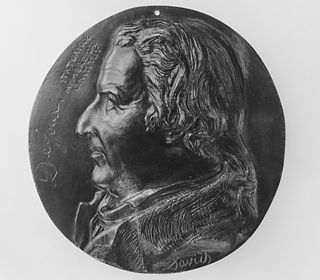
The Timurid Empire was a late medieval, culturally Persianate Turco-Mongol empire that dominated Greater Iran in the early 15th century, comprising modern-day Iran, Iraq, Afghanistan, much of Central Asia, the South Caucasus, as well as parts of contemporary Pakistan, North India and Turkey. The empire was culturally hybrid, combining Turko-Mongolian and Persianate influences, with the last members of the dynasty being "regarded as ideal Perso-Islamic rulers".
Bagrat V the Great from the Bagrationi dynasty was the son of the Georgian king David IX of Georgia by his wife Sindukhtar Jaqeli. He was co-ruler from 1355, and became king (mepe) after the death of his father in 1360.

George VII was king (mepe) of Georgia from 1393 to 1407. Bagrat V's son and successor, George put up a stiff resistance and had to spend much of his reign fighting Timur and his Empire.

Louis-Mathias, Count de Barral was a French church figure.
Sultan Ahmad was the ruler of the Jalayirid Sultanate, he was son to the most accomplished ruler of the sultanate, Shaykh Uways Jalayir. Early in his reign, he was involved in conflicts with his brothers. He would later suffer from several defeats with Timur and eventually imprisoned by the Mamluks. After being set free, he attacked his old enemy, the Qara Qoyunlu but was later captured and executed 1410.
The year 1791 in architecture involved some significant architectural events and new buildings.

The Timurid invasions of Georgia were eight invasions between 1386 and 1403 of the Kingdom of Georgia in the Caucasus by the Timurid Empire. Led by Timur, the Timurids ultimately conquered Georgia and made it a tributary state. However, Georgia, a Christian monarchy, was allowed to retain its independence and remain Christian.

Timur or Tamerlane was a Turco-Mongol conqueror who founded the Timurid Empire in and around modern-day Afghanistan, Iran, and Central Asia, becoming the first ruler of the Timurid dynasty. An undefeated commander, he is widely regarded as one of the greatest military leaders and tacticians in history, as well as one of the most brutal and deadly. Timur is also considered a great patron of art and architecture as he interacted with intellectuals such as Ibn Khaldun, Hafez, and Hafiz-i Abru and his reign introduced the Timurid Renaissance.
François Dominique de Barberie de Saint-Contest was a French Foreign Minister.

The Samtskhe-Saatabago or Samtskhe Atabegate, also called the Principality of Samtskhe, was a Georgian feudal principality in Zemo Kartli, ruled by an atabeg (tutor) of Georgia for nearly three and a half centuries, between 1268 and 1625. Its territory consisted of the modern-day Samtskhe-Javakheti region and the historical region of Tao-Klarjeti.

Eustache-Hyacinthe Langlois was a celebrated French painter, draftsman, engraver and writer. He became known as the "Norman Callot". He taught both his daughter Espérance Langlois and his son Polyclès Langlois and they often assisted him with drawings and engravings.

Henri-Pons de Thiard de Bissy was a French priest who was Bishop of Toul from 1687 to 1704, Bishop of Meaux from 1704 to 1737, and Cardinal from 1715 to 1737.
Marie François Fouquet (1590–1681), was a French medical writer and philanthropist.

Jean-François de Neufforge was a Belgian architect and engraver, known for his Recueil elementaire d'architecture, a book of architectural engravings.

Claude Dejoux was a French sculptor.
The Canon Sinuum is the main part of Bartholomaeus Pitiscus' Thesaurus Mathematicus sive Canon Sinuum ad radium 1.00000.00000.00000 published as a folio in 1613 in Frankfurt. It is a table of sines, originally computed by Rheticus, with the sines given every 10 seconds to 15 places, with first, second, and third differences. This table spans 270 pages.
Abraham Brodersson was a Scandinavian statesman and military commander who lived in the 14th and early 15th century.

The siege of Smyrna was fought between the Knights of Rhodes, who held the harbour and sea-castle of Smyrna in western Anatolia, and the army of the Turco-Mongol emir Timur. The Turco-Mongols blockaded the harbour and attacked the fortifications with stone-throwing siege engines, while the defenders, numbering only about 200 knights, countered with arrows and incendiary projectiles. After two weeks of strong resistance against a far superior adversary, the outer wall was destroyed by mining and breached. Some of the garrison managed to escape by sea, but the inhabitants and the city itself were destroyed.

The siege of Alinja occurred between the armies of the Jalayirid Sultanate and Timurid Empire starting in 1388. King George VII of Georgia attacked the Timurid besiegers of the Alinja castle in 1399, releasing those who had been imprisoned. In retaliation, Tamerlane ravaged southern Georgia and northern Armenia, killing, destroying, and enslaving people. The fortress managed to withstand the continued siege, but faced with starvation, surrendered in 1401.
The Timur's South Georgian campaign was a invasion led by Timur and Ibrahim I of Shirvan against George VII of Georgia in retaliation for George's role in the siege of Alinja.












